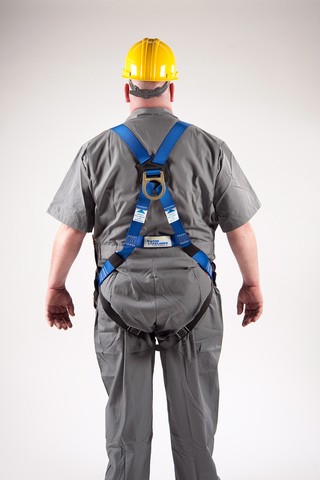
Understanding the Full Body Safety Harness; Functionality and Components
November 13, 2023
A full-body safety harness — also called body wear — is a critical element of every personal fall protection system. Workers across various industries performing job tasks at height rely on these systems for protection from potential workplace hazards, including construction sites, railcar operations and fire and rescue. While every part of a fall protection system is vital, the safety harness connects workers to the rest of the system and requires a secure, comfortable fit to work optimally.
Although the Occupational Safety and Health Administration (OSHA) has strict fall protection requirements for industrial applications, the American National Standards Institute (ANSI) defines performance requirements for safety harnesses, including minimum and maximum weight limits for workers and their gear. Full-body harnesses are the only acceptable form of body wear for all fall arrest applications.
Safety Harness Parts
A full-body harness combines the features of a chest harness and a sit harness to support the upper legs, hips, chest, and shoulders. The primary components of a safety harness system include:
- Straps: Saftey harnesses contain different fabric types and webbing sewn together to form the system’s waistband and various straps. Typical materials include polyester and nylon for standard systems and fabrics like Kevlar®, Nomex®, and Dyneema® for specialized applications. Padding sewn into the straps — particularly in the shoulder area — maximizes comfort and functionality.
- Buckles: The straps use buckles to tighten the harness system around the worker’s body. Common types of buckles include quick attachment, tongue, and spring tension. The straps and buckles are fully adjustable to accommodate each worker’s weight while providing comfort while working.
- Attachment points: The harness’s webbing contains various sewn-in attachment points made from plastic or forged metal. The locations of these points depend on the specific harness type and its application. Examples of attachment points include a D-ring on the back of the system, grommets on the waistband, and keepers to stow idle lanyards.
What Does a Full-Body Harness Fall Arrest System Do?
The primary responsibilities of a safety harness are to distribute forces safely across a worker’s body during a free fall and provide sufficient freedom of movement that allows the worker to perform their job effectively. When properly used, the full-body design contains the human torso and helps keep it upright during a fall event.
The D-ring on the back of the harness creates an attachment point for the safety lanyard that keeps the body upright. Depending on the application and specific function, D-rings can be on the sides or front of the harness for easy attachment of the positioning lanyards.
Choosing the Right Full-Body Safety Harness System
Selecting the correct full-body harness based on specific tasks and a worker’s characteristics is critical for maximizing safety. Safety managers must consider the following factors when choosing the optimal harness system:
- The system’s weight limit or rated capacity
- The number of required attachment points
- Potential fall distances
- Freedom of movement
- Worker comfort
- Environmental conditions
While ANSI-rated harnesses accommodate workers between 130 and 310 pounds, manufacturers like Rigid Lifelines® offer customized non-ANSI-rated harnesses for workers up to 410 pounds. Workers should never exceed these capacities because of the consequences that can occur during a free fall.
Rigid Lifelines® recommends that operations requiring safety harness capacities over 310 pounds consider establishing screening processes to ensure that all workers are healthy enough to perform work at elevation and conduct the proper self-rescue protocol if needed. In addition, the screening should make sure that workers are not susceptible to a rapid onset of suspension trauma.
Contact Rigid Lifelines® Today for More Information
If you want to learn more about full-body safety harnesses and which designs meet the requirements of your unique application, the Rigid Lifelines® team can assist you. With decades of experience in designing, engineering, and testing today’s most innovative fall protection systems, we are an unparalleled industry leader. Our engineers actively participate on the ANSI Fall Protection Code committee to stay current with industry regulations and technological advancements.
Connect with us online with questions, or find a local representative in your area to request additional information.
Categories
Share this post
Let us help you
Contact us today to find the perfect product fit for your job
